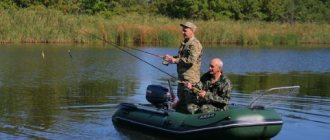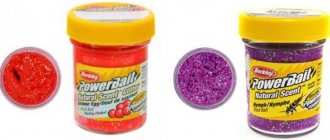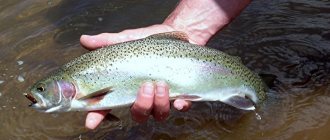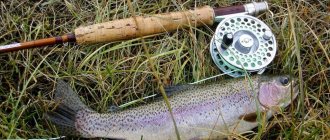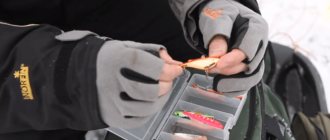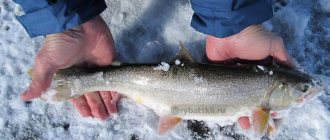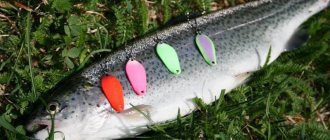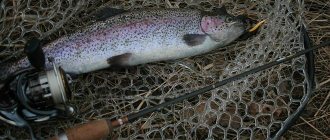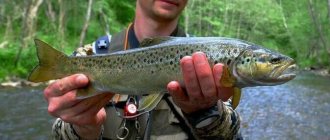In paid reservoirs, it grows somewhat faster and can reach a weight of 1.5 kg or more with a size of 50-70 cm. In natural conditions, especially in large reservoirs, trout can have a length of 70 cm or more and weigh 6 kg. Fishermen come across individuals weighing from 0.5 kg to 1 kg. Despite this, larger individuals are caught quite often.
At the same time, it should be noted that rainbow trout imported from America is more common in paid reservoirs.
When to fish for trout in winter?
First you need to decide on factors such as the start of winter trout fishing, as well as fishing conditions.
As soon as the reservoir is covered with ice, and its thickness should be such that it is absolutely safe to fish, you can safely take a winter fishing rod and go to the reservoir.
This fish is caught from morning until late evening, but with the onset of darkness, the bite may stop. Maximum trout activity occurs in the early morning, when the sun is just beginning to rise. Starting from 10 o'clock in the morning, it begins to move around the water area of the reservoir and the bite begins to weaken.
Rainbow trout began to be bred in paid reservoirs in America long before a similar approach began to be practiced in paid reservoirs in Russia and the CIS countries.
Where to fish for trout in winter?
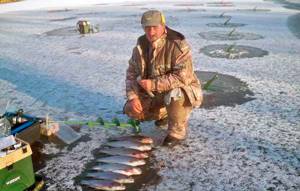
Paid reservoirs appear in various regions like mushrooms after rain. And it is not surprising, since the process of fishing occupies the minds of many representatives of the stronger half of humanity. This factor is actively used by businessmen to make a profit. This is due to the fact that people get tired of the everyday hustle and bustle and need some rest. Fishing is the most interesting way to spend time. Such a vacation is interesting for all family members, so whole families go fishing, not forgetting about small children. Moreover, on paid reservoirs you can not only have an interesting time, but also enjoy the fishing process. As a rule, a catch on such a body of water is guaranteed, but if you know where the trout are dispersed on the body of water, this will increase the chances of successful fishing.
The choice of place on a paid reservoir depends on how often fish are introduced into the reservoir. The trout, which were introduced several years ago, have already decided on their favorite places. She will feed in these places throughout her life. Trout can only be forced to leave these places by a sense of danger. In this regard, trout fishing from ice prefers a minimum of different noise.
If trout have recently been released, they are constantly moving around the water area of the reservoir. To catch it, you need to know the bottom topography, otherwise it’s unlikely to be possible to calculate its movement routes. If the reservoir is unfamiliar, then you can determine the directions of movement of the fish as follows:
- Determine the bottom topography to find out where the edges are located. To do this, holes are drilled in the direction from the shore to depth. If a difference in depth is detected, we can safely state that the edge has been found. Fishing is done at the very beginning of the decline in depth.
- Obtain information from the employees of the paid reservoir. They usually know exactly where promising places are located. Even not the most successful, but promising places will definitely delight you with a catch.
- Listen to the recommendations of experienced fishermen who often fish in this body of water. They are also aware of the characteristics of the bottom topography and make holes only in promising places.
- Old holes or traces from them can serve as a guide in identifying catchable places. It is quite possible that these holes helped to get a good catch. Therefore, there is a possibility that old holes will be quite catchy.
At the same time, it should be noted that trout can be found both at the very bottom and in the water column at any horizon. Therefore, trout fishing should be accompanied by a constant change in depth, especially when its bite stops.
What gear should I use?
It is best to purchase gear with plug-in carbon fiber or fiberglass rods. The length should not exceed 1.90 meters. Choose your handle carefully. It is advisable that it not be short. The preferred material is cork.
For trout fishing, it is recommended to use spoons . They can be completely different, but, often, fishermen purchase a narrow oscillating spoon with a heavy core. Its length reaches sixty-five millimeters, and its width reaches twenty. Weight about thirty grams. Silver-plated or tinned spoons are not used very often.
In addition, make sure you have an anti-twist that will help prevent the line from twisting. The spoon must pass very close to the fish's position in order to force it to make an instant attack.
You should choose a nylon fishing line with a diameter of 0.4 millimeters. You can also buy a thinner one - 0.2 mm.
Pay attention to the screw reel seat. This is the best option for spinning. It is this that best prevents the reel from falling out at the most intense moment of fishing. Tighten the reel brake to the limit, as trout have an incredibly high speed.
Tackle for winter trout fishing
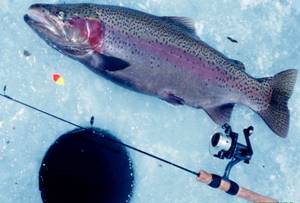
Trout fishing in winter involves the use of the following gear:
- winter float rods;
- winter fishing rods with a nod;
- Zherlits.
Moreover, the use of each tackle requires the use of unique baits. This fish is caught on a float rod using bloodworms or shrimp as bait. A winter fishing rod with a nod is the use of winter spinners and jigs. If fishing is carried out using girders, then live bait is the priority.
The use of this or that gear is of particular interest to fishermen. The float rod and nod rod are an active method of fishing that the angler gets a lot of pleasure from. Fishing with girders is a passive type of fishing, which is aimed at results, with minimal expenditure of effort and energy. Naturally, most anglers choose fishing rods with a nod in order to be constantly in the center of all the events. After all, winter fishing is not only about catching fish, but also a wonderful form of recreation, and an active one at that. As you know, only this way of spending time charges a person with energy.
How to catch trout?
It is almost impossible to see fish in the seething rapids, so catching trout in the rapids is very difficult . In most cases, you have to act at random, relying on fishing intuition.
the right bait for your trout . In cloudy water, it is best to use a fluorescent spoon. You need to throw it accurately and carefully.
Trout often settles in a hole formed under a fallen tree. In such cases, it is preferable to use a wobbler. When hunting from the shore, move upstream, not forgetting that the fish is standing with its head against it.
Having hooked a fish, the angler is faced with another problem - how to pull it ashore . The fish fights to the last, using techniques such as sharp jerks, unexpected turns, and jumps. You will have to put in a lot of effort and patience to stay with the loot.
Trout fishing is quite a difficult business . Therefore, an inexperienced fisherman can hardly hope for luck. It is possible to catch fish without sufficient experience only under the guidance of a competent mentor. This is a big lottery, so try it, gain knowledge and happy fishing!
Fishing for pike with a spinning rod in the summer. Read about this in our article.
And this article is about rigging a float rod.
In this section you will find many fascinating articles about winter fishing.
Lure and bait for trout fishing
Trout can be caught on any bait, including those that catch peaceful fish. Moreover, each body of water is characterized by its own fishing conditions, which requires the use of certain types of baits. And yet, some baits are universal and suitable for use on any body of water. This can be either natural bait or artificial bait. Fish preferences are determined based on the results of many experimental casts. Some fishermen, being in constant search, have certain secrets for catching various types of fish, including trout. Therefore, you need to try using various unusual attachments.
Trout baits
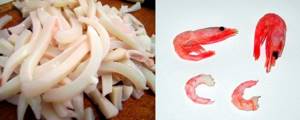
To catch this fish in winter, use classic baits, such as:
- shrimp, raw or boiled;
- worm;
- bloodworm;
- maggot;
- squid;
- trout paste;
- live bait
The list includes the most common types of bait that will not leave the angler without a bite. Shrimp can be used when fishing for trout using any gear, including girders. Live bait is used mainly when fishing with girders. At the same time, larger individuals bite on this bait if they are found in a given body of water.
Most winter trout fishing enthusiasts claim that shrimp is the most catchable bait if it is boiled. It is cooked in lightly salted water, without adding any spices. It can be attached to the hook either as a whole or in parts. The trout especially like the shrimp tail. You need to bait it so that the point of the hook does not show, otherwise the fish may prick itself and immediately spit out the bait.
If you plan to catch smaller trout, then baits such as bloodworms, maggots or worms are quite suitable. Despite this, the probability of catching a large specimen remains quite high.
If you visit a fishing store, you can buy trout paste there. It's similar to catching fish like carp with boilies. In other words, a special bait for catching a specific type of fish. By the way, it does its job well.
A bait such as salmon caviar works great at any time of the year. Unfortunately, this type of bait is unaffordable for most fishing enthusiasts in terms of cost. On the other hand, salmon caviar is an excellent and healthy food product, and what is the point of using it as bait is not at all clear.
Trout bait
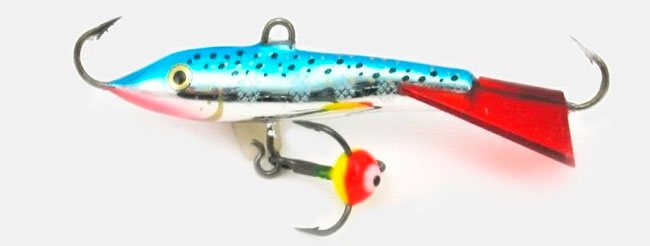
Trout can also be caught using artificial bait. As a rule, this is an active type of trout fishing, since you have to constantly make certain types of movements so that the action of the bait is more realistic and can interest the fish. In this case, you will have to fish not only the bottom area, but also some horizons located at some distance from the bottom. Moreover, you will have to constantly change the nature of the wiring in order to attract the attention of the trout.
The balancer is the most suitable and catchable bait for winter fishing for trout and other predatory fish, such as pike, perch and pike perch. As a rule, balancers with a length of 4 to 6 cm are used. Trout bite more actively if a bright bead is attached to the tee. Many experienced fishermen point out this feature. It is the presence of a bright bead that makes trout more aggressive and fishing more effective.
As for the colors of the balancers, there is no clear answer. This is due to the fact that the activity of fish is greatly influenced by atmospheric conditions. Therefore, you should resort to trial and error tactics to find the fish's weak point regarding flowers.
To begin with, the holes are fished with bait with a silver stripe, on a blue, green or bright green background. At the same time, trout can be caught on white, orange or other, but brightly colored balancers. They are more attractive to trout, although trout sometimes prefer duller or darker colors. Trout is as unpredictable as any other fish, and you have to work hard to catch it.
Video “Trout fishing on a balance beam”
Fishing for trout on a balance beam
Fishing technique
The technique for catching trout may vary from place to place. After all, the behavior of a predator is determined by the characteristics of its location. On the river it is freedom and choice of movement in different layers of water.
Arranging ambush sites for predators is often a necessary measure when fishing in wild streams. Here the depth is not as comfortable as on the river. When fishing on a pond, or on paid sites, there are also some nuances: let's talk about it.
How to catch trout using a spinning rod in a river
The most comfortable air t0 is 10-150C. Before going out onto the river you need to assess the area. Conduct visual reconnaissance; the best place will be a riffle on the river and the point from which the bait is cast. An important element of successful river fishing will be determining the escape route. You need to note the active behavior of predatory fish, but not be noticed yourself.
Before going out to the river, anglers need to have the sun shining in their backs. Clothes should be comfortable, not rustle, or disguise a person. Remember that silence on the river is one of the factors influencing the success of fishing.
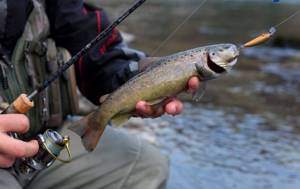
Finding the perfect place on a river with a riffle means you are guaranteed to catch a trophy
Brook trout fishing
In this case, it is necessary to feed the primaka and follow it downstream, since the predator has its mouth towards the stream. He is waiting to take the food floating towards him. The caught fish is carefully brought to the shore onto a quiet sandbank. It is obtained with a net with a short or long handle.
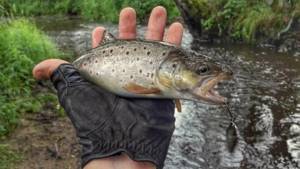
Predator caught in a stream, a coveted trophy
Fishing on the pond
Fishing for pond trout with a spinning rod can be successful if you know the points of greatest concentration of the predator. One of these is the place where water is supplied to the pond. You need to choose the appropriate bait and enjoy the process.
Balance game when fishing for trout
The use of a balancer requires a certain approach, which is to give the balancer a certain game. To do this, use a rod with a nod. The nod should be long, but soft, so that the movements are as uniform as possible. The balance bar is thrown upward, 20 centimeters with a movement of the hand, after which the hand is lowered to its original state. During this period, the balancer smoothly moves down, making a figure-of-eight motion. Such movements, as a rule, attract trout. When the bait is in its original position, you should not rush with a new upward movement. At this moment, a pause should be organized, lasting from 15 to 30 seconds. The basis of winter fishing is a pause, during which up to 90% of all bites occur. If you make constant movements, then this approach will not give you bites, and fishing will turn into a waste of time.
As mentioned above, the fish can be located at any distance from the bottom. Therefore, when fishing for trout, you should slowly climb up in steps of 50 cm if no bites were recorded. You can climb to the maximum height to the ice itself. Fish are unpredictable, and this must always be remembered.
If, when using one type of wiring, the result turned out to be zero, then it is better to move to another hole or use other types of wiring with longer pauses.
Trout fishing on paid reservoirs
Not everyone has time for a long trip to a fishing spot. Nowadays, there are many paid reservoirs where you can spend time with pleasure. Fishing with a spinning rod is an entertaining activity in its own way that brings joy to everyone. Feeling active resistance from a lively trout, while demonstrating all your skill and dexterity, is a great pleasure. However, the disadvantage of this fishing is that you have to pay for the pleasure of fishing.
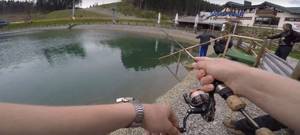
The advantage is a guaranteed catch and no need to travel many miles. Recently, bathhouses have been built on “pay zones”, which are usually located along the shore. In general, the banks are equipped in the best possible way: at the fishing site there is a low bridge on which you can sit. Due to the fact that paid places are visited by a large flow of people, the fish does not change its position, the trout skillfully moves away from the hook. Therefore, having found the right approach, every fisherman can be proud of himself.
It is best to come to the “pay zones” At this time, trout are most active and move throughout the entire reservoir rather than resting in the depths. Trout often lurks in underwater holes; if you find the right place next to one, a double catch is guaranteed.
Video on trout fishing in winter on girders
What to catch trout with
The best natural baits are: maggots, caddis larva, firefly, midges, live bait. Live bait can be a small fish with an elongated body. Commonly used fish species: minnow, trout, gudgeon.
The most effective vegetable baits : pearl barley, bread, corn.
Artificial baits. The following are used as bait:
- Spoons . Use number three spinners with a fast needle. Priority is given to spinners with a golden hue. This bait has the following advantages: applicable at great depths; are reusable; used in different fishing conditions.
- Wobblers . Buy oscillating wobblers from four to ten centimeters long. Advantages: imitate a live fish, attracting the attention of a predator; used at different depths; have a game that copies the movements of living fish.
- Twisters . Use bait no longer than 5 cm. It will be better when the “rubber” is “edible”, because fish often bite the bait, so the “edibility” of the bait plays a big role.
- Artificial worms . It is this bait that is most often used by fishermen on paid sites. The worm needs to be equipped with a jig head. The placement of the bait does not play a special role. Both classic and “weki” are used, when the silicone bait is pierced exactly in the middle. “Wacky” is used when fishing at shallow depths; at greater depths, use the classic one.
- Crustaceans and nymphs . Since this bait sinks slowly, it is used only in the upper layers of water. The wiring should be selected by testing, as well as the color of the bait. Use different weights of sinker heads. Mostly they reach 0.8-0.10g when fishing in the middle layers of water.
- Balancer . Using a balancer is a sure way to increase the bite frequency. Excellent for winter trout fishing. The size of the bait is 5 cm. There is no universal color, so you will have to experiment. Experienced fishermen advise attaching a shiny bead to the balancer. So, the fish will be more willing to take the bait. Using a balancer is not so easy, and the fishing result will depend on your special approach.
- Pasta , they are also boilies. These are spherical baits that attract fish with their smell. Boilies can be dusty, which means that they are sprayed into the water, spreading taste throughout the pond. The fish reacts instantly.
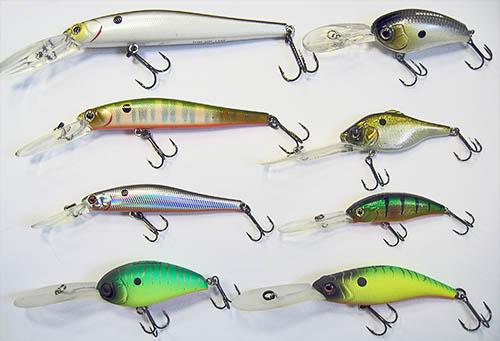
Wobblers for trout
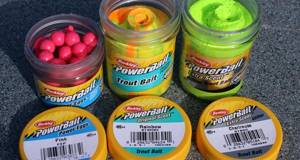
Pasta, boilers
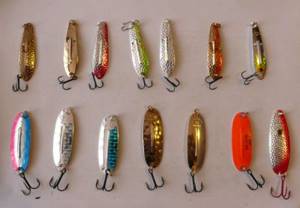
In order for the “game” to take on a special shade, use a rod and a nod. The nod should be long, but not harsh . This is necessary so that the movements are not sudden. Throw the balancer 25-30 cm, then lower your hands to the starting position. At this time, the balancer reaches to the bottom, rotating in the form of a figure eight. After the bait is in its original position, pause briefly for a few seconds. The peculiarity of fishing in winter lies in the low dynamics of movements. Frequent movements can leave you without a catch.
Fishing for trout in winter using lures

Not only fishing with a balance beam can be effective. The use of spinners for vertical trolling can be just as effective, depending on the fishing conditions. The movement of the spoon is characterized by the fact that it does not move in a figure eight when gliding, but deviates in different directions, which also attracts trout.
For winter trout fishing, elongated spinners with painted eyes are more suitable. As a rule, such spoons resemble fish fry. Basically, trout respond to copper or silver-colored spoons, but very often they also take colored baits.
Playing with a spinner is not much different from playing with a balancer. The beginning of the game consists of a sharp rise of the spoon by 50 centimeters, after which the fishing rod returns to its original state, and the spoon glides freely in the water column. Here it is also very important to have pauses lasting several seconds. This is when the bait attack occurs. First, the trout takes aim, and then, when the bait has almost stopped, the bite occurs.
Depending on the conditions, spoons are used both with bare hooks and with bait attached to them. If the trout is actively biting, then there is no point in additional bait, but if the fish behaves passively, then it makes sense to use an additional element to interest the trout.
Video “Trout fishing with lures in winter”
Fishing for trout in winter using spoons
Fishing with a jig
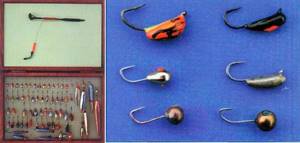
Particularly popular among winter fishing enthusiasts is artificial bait such as jigs. Sometimes it can be more catchy than any spinner or balancer. At the same time, jigs are used to catch predators such as perch.
It should be noted that trout do not pay special attention to the shape of the jig and its color. Some fishermen use regular jig heads instead of a classic jig.
The weight of the jig can be between 3-8 grams. The hooks used are branded sharp hooks with a long shank to minimize idle bites. If the trout behaves passively, then the bite can be activated if you attach bait in the form of bloodworms or maggots to the jig hook.
Playing with a jig
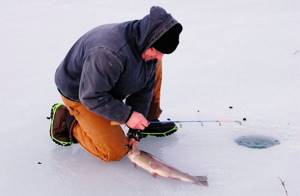
Depending on the behavior of the fish, the type of game with a jig is selected. At the same time, it should be remembered that without organizing pauses during the movement of the jig in the water column, you can be left without any bites at all. You can count on success if you apply the technique of playing with a jig, proven over the years. It is as follows: the jig rises up 50 cm, followed by a pause, allowing the jig to smoothly return to its original position, and again a pause before moving the jig up. Similar movements are repeated several times until the fish becomes interested in the bait. At the same time, you should not stay long on one hole. If after carefully fishing the hole there are no bites, then you need to move on to the next hole. It is quite possible that the hole was drilled in an unpromising place, given the fact that the fish sticks to their favorite places.
The choice of bait game is selected depending on the activity of the trout, but any game is characterized by the presence of basic movements, such as:
- lowering and raising the jig - on average about 15 cm;
- pause from 15 to 30 seconds.
As a rule, the amplitude of movements can be reduced or increased, as well as the duration of pauses. If the trout is very sluggish, then the pauses can be increased to 1 minute, and the movements should be fairly uniform and slow.
